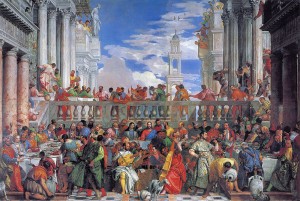Favourite artist: Paolo Veronese
Favourite artist: Paolo Veronese
Favourite artist: Paolo Veronese
-
Hannah
-
Hannah
 Regular readers of my blog will have spotted a common theme in the sources of my inspiration:
Regular readers of my blog will have spotted a common theme in the sources of my inspiration:
Colour!
And that is, for me, a key reason that I love the vivid artworks of Venetian painter Paolo Veronese. As you can see from the painting I’ve included here, The Wedding at Cana, Veronese was a colourist whose works are full of passion and movement and detail and grandeur that they reach out and grab your attention, demanding to be absorbed and appreciated.
Veronese was an artist of the sixteenth century who, along with Titan and Tintoretto, was one of the leading painters of the Italian Renaissance period. Along with his use of colour, which was inspired by Titan, he is widely known for two elements of his works:
- Religious and mythological subject matters: He was especially respected for the biblical scenes he painted for monasteries in Venice and Verona, such as The Conversion of Mary Magdalene and The Deposition of Christ. He gained a reputation as the very finest of ceiling fresco painters.
- Vast sizes: The Benedictine monks of the San Giorgio Maggiore Monastery commissioned Veronese to create a 66-square-metre painting: The Wedding at Cana. And The Feast in the House of Levi measured more than five metres high and more than twelve metres wide and was one of the largest canvases created in the world in that century.
The Feast in the House of Levi is remembered for more than its size, however: it earned Veronese an audience with the Inquisition, who took exception to some of the details of what was a Last Supper scene, which included dwarves and a variety of animals. In his defence, Veronese told his inquisitors, ‘We painters use the same license as poets and madmen.’ Rather than repaint the scene to please the Inquisition, he retitled it so that it was no longer a depiction of the Last Supper.
Some interesting facts about Veronese:
- He was born Paolo Spezapreda, but he adopted the name Caliari, which was the name of his grandfather, Antonio Caliari, from whom he was illegitimately descended. He signed the name Paolo Veronese for several years on his paintings; Veronese draws on his birthplace, Verona.
- Veronese’s brother, sons and nephews worked with him in his workshop, and painted after his death in his style, signing their works Haeredes Pauli (Heirs of Paolo).
If you’re a British reader, or plan to visit London this spring, and you’re interested in Paolo Veronese, be sure to take in the forthcoming exhibition of his works at the National Gallery on Trafalgar Square. The exhibition is entitled ‘Veronese: Magnificence in Renaissance Venice’ and it will run from 19 March – 15 June 2014. If you have time while visiting the gallery, I can highly recommend the National Dining Rooms restaurant there, a beautifully designed space and a fine menu that changes monthly to focus on a different county’s cuisine.
[CW1] Paolo Veronese